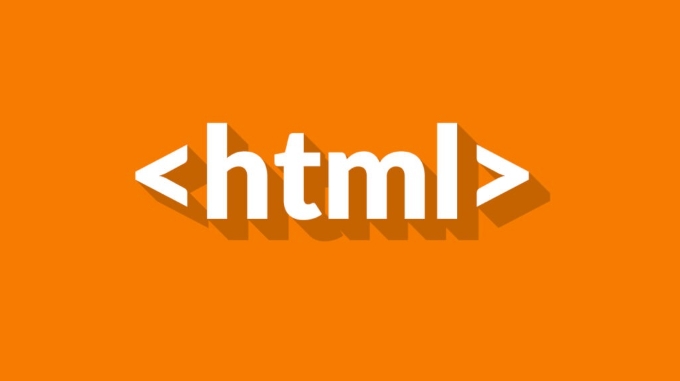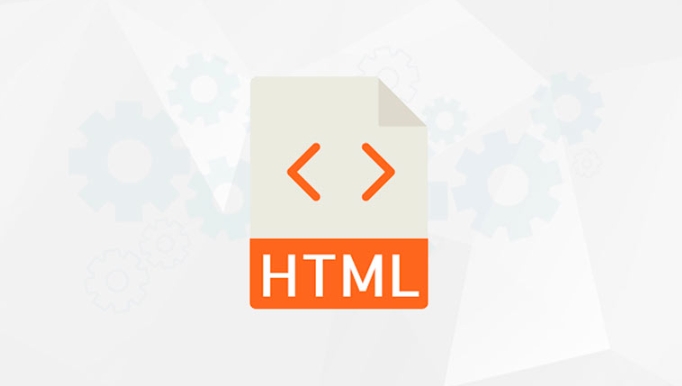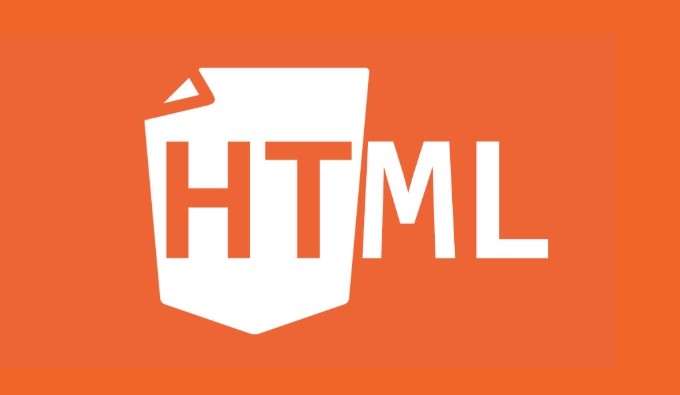Implementing Clickable Buttons Using the HTML button Element
Jul 07, 2025 am 02:31 AMTo use HTML button elements to achieve clickable buttons, you must first master its basic usage and common precautions. 1. Use the

Using HTML button elements to achieve clickable buttons is actually quite direct. As long as you write the right label and add the basic style, you can see a button on the web page that can dot and trigger actions. The key is to understand the basic usage of the button tag and its common usage scenarios.

Button Basics: How to write the easiest button
The easiest way to create a button in HTML is to use the <button></button> tag. You can write this way:

<button>Click me</button>
By default, this button will display the words "Click Me" and is clickable. You can also add type attributes to it, such as type="button" (normal button), type="submit" (submit form), or type="reset" (reset form). If type is not specified, the default is submit , which is easily overlooked, especially in non-form scenarios.
Add interactive features to the buttons
It's not enough to have buttons, you have to make it capable. Usually we will bind click events through JavaScript. For example:

<button onclick="alert('You clicked the button!')">Try it</button>
You can also use JS separation writing method to make it easier to maintain:
<button id="myBtn">Click to try</button>
<script>
document.getElementById('myBtn').addEventListener('click', function() {
alert('You clicked the button!');
});
</script>This approach is more suitable for complex projects, especially when multiple operations or logical judgments are required.
How to adjust the button style to look good
Although the browser's own buttons can also be used, many times we need to customize the appearance. You can use CSS to modify background color, border, rounded corners, etc.:
<style>
.custom-btn {
background-color: #007BFF;
color: white;
border: none;
padding: 10px 20px;
border-radius: 5px;
cursor: pointer;
}
.custom-btn:hover {
background-color: #0056b3;
}
</style>
<button class="custom-btn">Submit</button>- The color contrast should be obvious, which is convenient for users to identify
- It is best to set both hover and active status to improve interaction
- The button size should be considered on the mobile terminal, and it should not be too small or not.
Frequently Asked Questions and Notes
Sometimes the button looks normal, but it does not click or behaves abnormally. There are several common reasons:
- Forgot to close
disabledproperty - The button type is set to
submit, but it is not in the form form, resulting in unintuitive behavior. - The JS event is not bound correctly, or the function name is wrongly spelled
- Buttons are blocked by other elements, especially when the layout is complex
When you encounter problems, you can:
- Open the browser developer tool to check element status
- Check whether there is any JS error in the console
- Simplified structure test minimum runnable code
Basically that's it. Although the button is simple, you still need to pay more attention to the details when you use it well.
The above is the detailed content of Implementing Clickable Buttons Using the HTML button Element. For more information, please follow other related articles on the PHP Chinese website!

Hot AI Tools

Undress AI Tool
Undress images for free

Undresser.AI Undress
AI-powered app for creating realistic nude photos

AI Clothes Remover
Online AI tool for removing clothes from photos.

Clothoff.io
AI clothes remover

Video Face Swap
Swap faces in any video effortlessly with our completely free AI face swap tool!

Hot Article

Hot Tools

Notepad++7.3.1
Easy-to-use and free code editor

SublimeText3 Chinese version
Chinese version, very easy to use

Zend Studio 13.0.1
Powerful PHP integrated development environment

Dreamweaver CS6
Visual web development tools

SublimeText3 Mac version
God-level code editing software (SublimeText3)

Hot Topics
 How do I stay up-to-date with the latest HTML standards and best practices?
Jun 20, 2025 am 08:33 AM
How do I stay up-to-date with the latest HTML standards and best practices?
Jun 20, 2025 am 08:33 AM
The key to keep up with HTML standards and best practices is to do it intentionally rather than follow it blindly. First, follow the summary or update logs of official sources such as WHATWG and W3C, understand new tags (such as) and attributes, and use them as references to solve difficult problems; second, subscribe to trusted web development newsletters and blogs, spend 10-15 minutes a week to browse updates, focus on actual use cases rather than just collecting articles; second, use developer tools and linters such as HTMLHint to optimize the code structure through instant feedback; finally, interact with the developer community, share experiences and learn other people's practical skills, so as to continuously improve HTML skills.
 How do I embed PHP code in an HTML file?
Jun 22, 2025 am 01:00 AM
How do I embed PHP code in an HTML file?
Jun 22, 2025 am 01:00 AM
You can embed PHP code into HTML files, but make sure that the file has an extension of .php so that the server can parse it correctly. Use standard tags to wrap PHP code, insert dynamic content anywhere in HTML. In addition, you can switch PHP and HTML multiple times in the same file to realize dynamic functions such as conditional rendering. Be sure to pay attention to the server configuration and syntax correctness to avoid problems caused by short labels, quotation mark errors or omitted end labels.
 How do I embed video in HTML using the element?
Jun 20, 2025 am 10:09 AM
How do I embed video in HTML using the element?
Jun 20, 2025 am 10:09 AM
To embed videos in HTML, use tags and specify the video source and attributes. 1. Use src attributes or elements to define the video path and format; 2. Add basic attributes such as controls, width, height; 3. To be compatible with different browsers, you can list MP4, WebM, Ogg and other formats; 4. Use controls, autoplay, muted, loop, preload and other attributes to control the playback behavior; 5. Use CSS to realize responsive layout to ensure that it is adapted to different screens. Correct combination of structure and attributes can ensure good display and functional support of the video.
 How do I minimize the size of HTML files?
Jun 24, 2025 am 12:53 AM
How do I minimize the size of HTML files?
Jun 24, 2025 am 12:53 AM
To reduce the size of HTML files, you need to clean up redundant code, compress content, and optimize structure. 1. Delete unused tags, comments and extra blanks to reduce volume; 2. Move inline CSS and JavaScript to external files and merge multiple scripts or style blocks; 3. Simplify label syntax without affecting parsing, such as omitting optional closed tags or using short attributes; 4. After cleaning, enable server-side compression technologies such as Gzip or Brotli to further reduce the transmission volume. These steps can significantly improve page loading performance without sacrificing functionality.
 How has HTML evolved over time, and what are the key milestones in its history?
Jun 24, 2025 am 12:54 AM
How has HTML evolved over time, and what are the key milestones in its history?
Jun 24, 2025 am 12:54 AM
HTMLhasevolvedsignificantlysinceitscreationtomeetthegrowingdemandsofwebdevelopersandusers.Initiallyasimplemarkuplanguageforsharingdocuments,ithasundergonemajorupdates,includingHTML2.0,whichintroducedforms;HTML3.x,whichaddedvisualenhancementsandlayout
 How do I use the element to represent the footer of a document or section?
Jun 25, 2025 am 12:57 AM
How do I use the element to represent the footer of a document or section?
Jun 25, 2025 am 12:57 AM
It is a semantic tag used in HTML5 to define the bottom of the page or content block, usually including copyright information, contact information or navigation links; it can be placed at the bottom of the page or nested in, etc. tags as the end of the block; when using it, you should pay attention to avoid repeated abuse and irrelevant content.
 What is the declaration, and what does it do?
Jun 24, 2025 am 12:57 AM
What is the declaration, and what does it do?
Jun 24, 2025 am 12:57 AM
Adeclarationisaformalstatementthatsomethingistrue,official,orrequired,usedtoclearlydefineorannounceanintent,fact,orrule.Itplaysakeyroleinprogrammingbydefiningvariablesandfunctions,inlegalcontextsbyreportingfactsunderoath,andindailylifebymakingintenti
 How do I use the tabindex attribute to control the tab order of elements?
Jun 24, 2025 am 12:56 AM
How do I use the tabindex attribute to control the tab order of elements?
Jun 24, 2025 am 12:56 AM
ThetabindexattributecontrolshowelementsreceivefocusviatheTabkey,withthreemainvalues:tabindex="0"addsanelementtothenaturaltaborder,tabindex="-1"allowsprogrammaticfocusonly,andtabindex="n"(positivenumber)setsacustomtabbing






